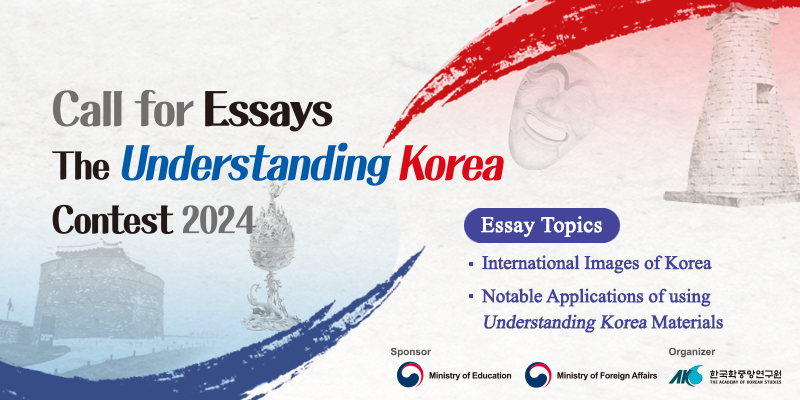Essay Contest Result

International Images of Korea: A Comprehensive Analysis
Introduction
A global and accurate understanding of a country is a multidimensional issue that is shaped by diverse sources such as international textbooks, online resources, media, and cultural exchanges. As a country known for its rich cultural heritage and rapid and developed modernization, Korea is a prime example of this. This article examines the image of Korea in international educational sources and offers strategies to enrich and expand this image, ensuring that it reflects the contemporary reality and historical depth of the country.Images of Korea in International Instructional Materials
Historical Focus and Stereotypes
International textbooks and educational resources often present a skewed or incomplete picture of Korea. Historically, these materials have focused predominantly on significant events such as the Korean War, Japanese colonization, and the struggle for independence. While these are undoubtedly important aspects of Korean history, such a narrow focus can lead to an incomplete understanding of the country.Additionally, stereotypes and simplistic portrayals are common. For example, Korea is often depicted through a limited cultural lens, emphasizing traditional elements like Hanbok (traditional Korean clothing), Kimchi, and K-pop. These elements, while integral to Korean culture, do not fully capture the nation's complex and dynamic society.
Digital Representations
The internet, as a global repository of information, presents a more varied but equally challenging landscape. Websites and online content about Korea can range from highly informative to misleading. Popular internet sites and social media platforms often highlight sensational aspects of Korean culture, such as the global phenomenon of K-pop and Korean dramas (K-dramas). While these contribute positively to Korea's soft power, they can overshadow other critical aspects of Korean life, such as technological innovations, economic development, and social changes.Media Portrayal
Mainstream media coverage, especially in Western countries, tends to focus on geopolitical tensions involving North Korea, often casting a shadow over South Korea’s achievements. This skewed coverage can lead to an imbalanced perception of the Korean Peninsula, overshadowing South Korea’s vibrant democracy, economic prowess, and cultural richness.Proposals to Improve the Image of Korea
To present a more balanced and accurate image of Korea internationally, a multi-faceted approach is necessary. Here are several proposals aimed at improving and diversifying Korea's image:Comprehensive Curriculum Development
1. Integration of Contemporary Achievements: Updating international educational curriculums to include Korea’s modern achievements in technology, economy, and global diplomacy is essential. By presenting Korea's advancements in fields such as electronics, robotics, and green energy, educational materials can offer a broader perspective.2. Collaborative Projects: Establishing partnerships between Korean educational institutions and international publishers can ensure the inclusion of accurate and current information. Collaborative projects could involve joint curriculum development, exchange programs for educators, and shared educational resources.
3. Incorporation of Diverse Perspectives: Encouraging a more holistic approach in educational materials that includes social, economic, and cultural dimensions of contemporary Korea. This can help students understand Korea not just as a historical entity but as a living, evolving society.
Enhanced Digital Presence
1. Diversified Online Content: Creating and promoting a wide range of digital content that highlights different facets of Korean society can help in building a more nuanced image. Government and private sector collaborations could result in high-quality documentaries, virtual tours, and educational videos about various aspects of Korean life, including its history, modern achievements, and future aspirations.2. Influencer Partnerships: Engaging with international influencers and content creators to produce and share content about Korea can reach diverse audiences. These influencers can provide authentic and relatable perspectives on Korean culture, technology, and lifestyle, thereby broadening the global understanding of Korea.
3. Multilingual Platforms: Developing multilingual platforms and content to reach a wider global audience. By providing content in multiple languages, Korea can ensure its message is accessible to non-English speaking populations, thus broadening its reach.
Interactive Learning and Cultural Exchange
1. Virtual Exchange Programs: In an increasingly digital world, virtual cultural exchange programs can facilitate cross-cultural interactions. These programs can connect students and educators from different parts of the world, allowing them to engage in collaborative projects and discussions about Korea, its culture, and its advancements.2. Interactive Online Modules: Developing interactive online learning modules that cover various aspects of Korea can be an effective educational tool. These modules could include virtual reality experiences, interactive timelines of Korean history, and gamified learning experiences about Korean innovations and culture.
3. Student and Teacher Exchange Programs: Expanding student and teacher exchange programs can provide first-hand experience of Korean culture and society. Participants can bring back their experiences and share them, fostering a more accurate and positive image of Korea in their home countries.
Public Diplomacy and Cultural Diplomacy
1. Global Cultural Centers: Expanding the reach of Korean cultural centers around the world can promote a deeper understanding of Korea. These centers can host exhibitions, language classes, cultural workshops, and film screenings that showcase Korea’s rich cultural heritage and contemporary society.2. International Festivals and Competitions: Organizing and participating in international festivals, competitions, and expos can highlight Korea's cultural and technological prowess. Events like the Korean Wave Festivals (Hallyu) and technology expos can attract global attention and admiration.
3. Government Initiatives: Strengthening government initiatives aimed at promoting Korean culture and achievements abroad. This could include more robust funding for cultural programs, scholarships for international students, and support for Korean artists and innovators to present their work internationally.
Media Engagement and Representation
1. Proactive Media Relations: Building stronger relationships with international media to ensure accurate and comprehensive coverage of Korea. This can involve regular press briefings, media tours, and providing resources and information to foreign journalists.2. Content Creation and Distribution: Producing high-quality content that highlights various aspects of Korean society, from daily life to technological advancements, and distributing it through international media channels.

